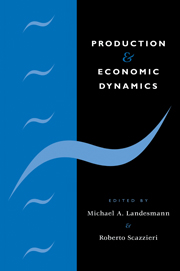Book contents
- Frontmatter
- Contents
- List of figures
- List of tables
- List of contributors
- Preface
- Introduction: Production and economic dynamics
- Part I Decomposition of economies and structural dynamics
- 1 Traverse analysis in a neo-Austrian framework
- 2 Vertical integration, the temporal structure of production processes and transition between techniques
- 3 Production and efficiency with global technologies
- 4 Efficient traverses and bottlenecks: a structural approach
- 5 Structural change and macroeconomic stability in disaggregated models
- Part II Production organisation and economic dynamics
- Name index
- Subject index
4 - Efficient traverses and bottlenecks: a structural approach
Published online by Cambridge University Press: 27 March 2010
- Frontmatter
- Contents
- List of figures
- List of tables
- List of contributors
- Preface
- Introduction: Production and economic dynamics
- Part I Decomposition of economies and structural dynamics
- 1 Traverse analysis in a neo-Austrian framework
- 2 Vertical integration, the temporal structure of production processes and transition between techniques
- 3 Production and efficiency with global technologies
- 4 Efficient traverses and bottlenecks: a structural approach
- 5 Structural change and macroeconomic stability in disaggregated models
- Part II Production organisation and economic dynamics
- Name index
- Subject index
Summary
Introduction
Within the analysis of multisectoral growth models emphasis has in the last two decades shifted to problems of structural change and technological unemployment. The analysis of an economy which originally has been in a steady-state equilibrium but which was disturbed by a change in one of the exogenous determinants of growth, such as technical progress, the supply of labour or natural resources, is one of the most challenging problems in economics. The investigation of the macroeconomic consequences of such disturbances and of the conditions that have to be fulfilled in order to bring the economy back to an equilibrium growth path, is at the centre of traverse analysis, which ‘is the easiest part of skiing, but the hardest part of economics’. Although traverse analysis is linked with equilibrium growth which it takes as a starting point, in contrast to long-run balanced growth analysis it is a short- or medium-run analysis which marks an important step forward in coping with the dynamic nature of the problems and thus rejuvenating growth theory by liberating it from the overall preoccupation with steady-state growth paths. Pioneers in the field of traverse analysis are Adolph Lowe (1976) and John Hicks (1965, 1973) who in chapter 16 of his Capital and Growth was the first to formally define a traverse.
Suppose that we have an economy which has in the past been in equilibrium in one set of conditions; and that then, at time 0, a new set of conditions is imposed; is it possible (or how is it possible) for the economy to get into the new equilibrium, which is appropriate to the new conditions? […]
Information
- Type
- Chapter
- Information
- Production and Economic Dynamics , pp. 140 - 166Publisher: Cambridge University PressPrint publication year: 1996
Accessibility standard: Unknown
Why this information is here
This section outlines the accessibility features of this content - including support for screen readers, full keyboard navigation and high-contrast display options. This may not be relevant for you.Accessibility Information
- 4
- Cited by
